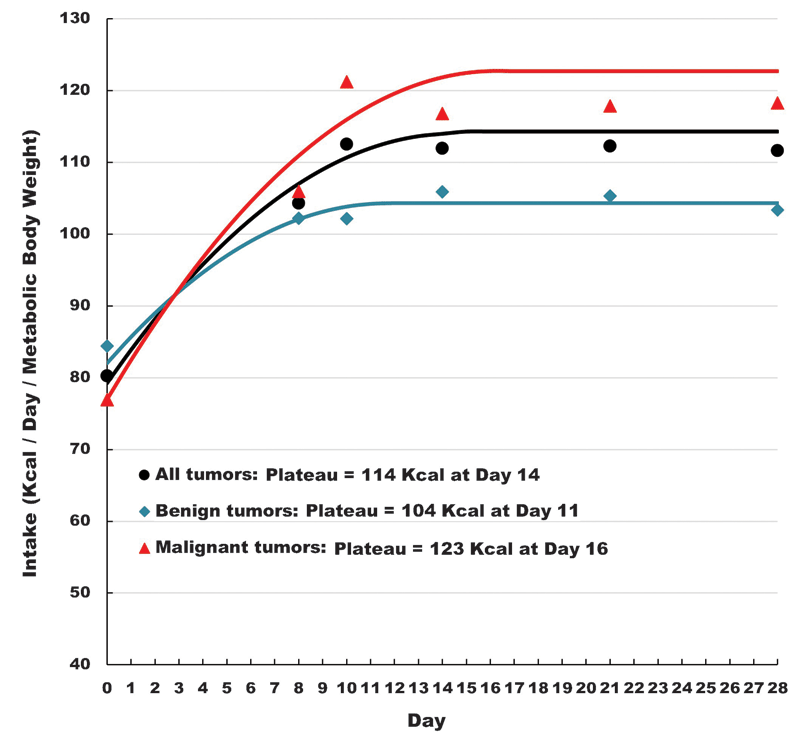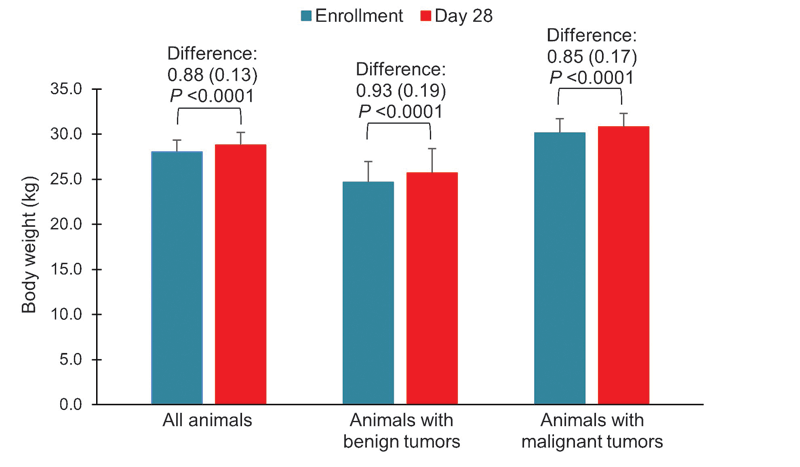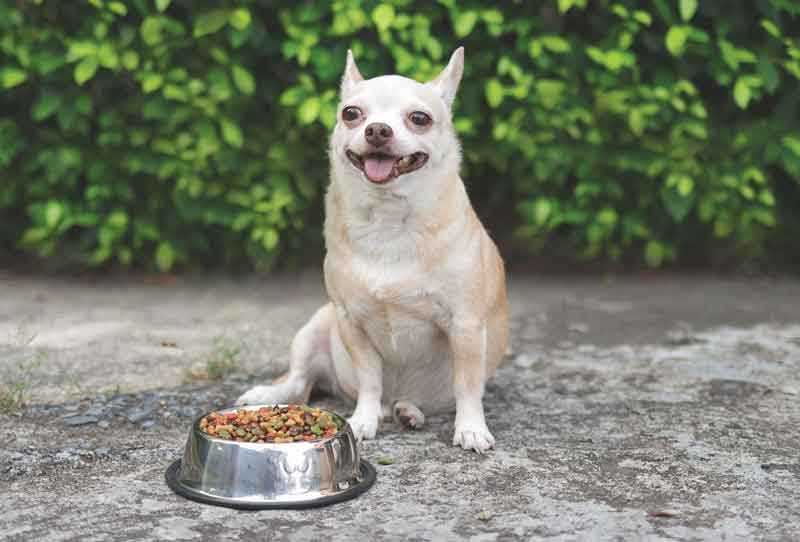Cancer is common in dogs and cats, especially as they age, and is a leading cause of pet death globally. It is estimated one out of four dogs and one out of five cats will develop cancer in their lifetimes. In the U.S., an estimated six million dogs and six million cats are diagnosed with cancer each year, while 13-25 million dogs are living with cancer.1,2
Malnutrition
One of the major issues that can arise during cancer treatment in cats and dogs is malnutrition. Cancer and its treatment often have negative effects on feeding behavior, including loss of appetite. Inability to consume adequate amounts of nutrients and calories can lead to malnutrition and weight loss. The nutritional status in dogs and cats with cancer is also negatively altered by cachexia, which is driven by systemic inflammation as a result of the cancer disease process. Cachexia differs from simple starvation in that both protein and fat stores are lost almost simultaneously, accelerating deterioration of the clinical status.
Living with cancer can cause waxing and waning appetite or complete loss of appetite for various reasons. If a tumor is within the GI tract, it may interfere with food intake and may cause trouble for pets to swallow and digest food, or absorbing nutrients from the intestinal tract. Additionally, cancer disease processes can cause pain, stress, nausea, or dehydration, which can reduce a pet’s appetite.
Surgery, radiation, or chemotherapy can also contribute to loss of appetite via changes in the sense of taste or smell, feeling pain, nausea, vomiting, constipation, or diarrhea. The time of noticeable onset of cancer cachexia may vary in dogs and cats. However, the unwillingness of the pet to eat is easily noted and is known to be the major contributor to an owner’s decision to elect euthanasia. Conversely, when a pet appears to enjoy their food, pet parents have a favorable perception of their pet’s quality of life.
There are different ways to make eating more enjoyable for the pet—offering foods and food forms the pet likes or preparing homemade or “people” foods. The drawback of feeding people foods, however, is unless a recipe formulated by a board-certified veterinary nutritionist is followed, individual people foods are not a complete and balanced option for pets and may contain ingredients that can be harmful under certain organ dysfunction (e.g. excess sodium, protein, fat or inclusion of garlic, onions, lactose). Therefore, there is an unmet need for palatable commercial foods designed for pets living with cancer.
The study
Animal nutrition scientists initiated research on nutritional support for pets living with cancer about five years ago. The goal was to develop complete and balanced dog and cat foods that would address the nutritional challenges of cancer patients, including the decreased interest in eating. The challenge of designing such commercial pet foods was to find the right balance between nutritional attributes of the foods and their palatability. The scientists collected and evaluated multiple information sources to understand the nutritional needs of pets with cancer.3 This included gathering insights from pet parents and veterinary healthcare team members, including board-certified specialists in oncology, nutrition, and feline medicine.
The new food formulation created from the research was evaluated in a multi-center, prospective, uncontrolled feeding study of dogs with benign or malignant tumor.4 The study was designed to test the food acceptance, eating enthusiasm, and to evaluate the nutritional status and quality of life of these patients. It was hypothesized that canine cancer patients would have high acceptance of the new food and maintain eating enthusiasm, which would result in an improved caloric and nutrient intake required to maintain quality of life.
Dogs were fed the dry version of the new therapeutic canine food for 28 days, including seven days of transitioning to the new food. Pet owners were blinded to the study sponsor. Veterinarians assessed body weight and laboratory testing at the beginning and end of the study, while pet owners evaluated eating enthusiasm, food intake, quality of life, and stool quality throughout the study. Pet owners used a scientifically validated emoji scale (Figure 1) to assess their pet’s eating enthusiasm from least enthusiastic to the most enthusiastic.5

Photo courtesy Iveta Becvarova
Based on the received input, and after reviewing the most current published evidence, scientists identified the highest priority features of a food for dogs or cats with cancer:
- Flavor. Great taste that pets will eat with obvious enthusiasm—this was the single most important feature.
- Nutrition. Complete and balanced food that meets the nutritional needs of pets with cancer and can be fed long-term for maintenance.
- Calories. High-calorie and nutrient-dense, packed inside a smaller volume so pets can meet their nutritional needs even when eating less food.
- Texture. Easy to eat and digest because pets may have difficulty chewing and/or digesting food due to the cancer itself or cancer treatments.
- GI-friendly. A food that nourishes the GI tract because decreased appetite, nausea, and diarrhea are common in cancer patients.
A total of 65 dogs were included in the study. Twenty-five dogs had benign tumors and 40 had malignant tumors. Enrolled dogs were from 13 general or oncology specialty practices in the U.S. Of the dogs enrolled, 97 percent successfully transitioned over seven days to eating the study food. Mean eating enthusiasm score on the emoji scale for all dogs at the time of enrollment was high at 6.1, and continued to stay high during the study. Intake (in grams and calories) gradually increased for all dogs and plateaued at day 14, as expressed as kcal/day/metabolic body weight (Figure 2). Body weight increased significantly at day 28 in both groups when compared with baseline (Figure 3).

Dogs in the malignant tumor group experienced significant improvements in “acting like normal today” and “dog is joyful today” when compared with baseline. Fecal scores (1=liquid diarrhea, 5=firm feces) did not change over time and consistently remained above four for all dogs during the study.

Findings
The study demonstrated high acceptance and continued eating enthusiasm of a new therapeutic food in dogs with cancer. There was a significant increase in the amount of food consumed and caloric intake, which was associated with positive effects on body weight, stool consistency, and quality of life. GI issues, such as diarrhea and sometimes constipation, are common in pets with cancer, either associated with cancer or a side effect of cancer treatment or pain management. Therefore, the study food contained a unique blend of prebiotic fibers that nourished gut microbiome and supported consistent stool quality.
There are a few instances where this food would not be appropriate. Due to the relatively high fat content (around 25 percent on dry matter basis), it is not ideal for pets with or at an increased risk for fat-sensitive conditions such as pancreatitis, hyperlipidemia, or lymphangiectasia.
Although the amount of phosphorus is moderate, the protein is more than is recommended for pets with chronic kidney disease (CKD), especially those with renal proteinuria or IRIS stages 2-4 CKD. Due to its high caloric density, it may not be ideal for overweight or obese pets with cancer if losing weight is a goal. However, it is a great option if the overweight/obese pet is not eating adequate calories to meet their nutritional needs.
It is recommended to start any new therapeutic food at the initial cancer diagnosis, with a gradual transition over seven days. This gives pet parents some control and allows them to be involved in their pet’s care. Additionally, it is something they can start right away, while waiting on decisions about cancer treatments (chemotherapy, radiotherapy, immunotherapy). It is appropriate to feed this food long-term to most dogs and cats with any type of cancer (malignant or benign), whether they are receiving conventional cancer treatments or when a pet parent has elected not to pursue cancer treatment.
In summary, cancer commonly affects dogs and cats and increases the risk for malnutrition and important consequences, including decreased response to treatment, shorter remission times, and decreased quality of life. It is important to select a therapeutic food that offers nutritional support while also being designed with exceptional taste for dogs and cats with all types of cancer.
Iveta Becvarova, DVM, MS, Diplomate ACVIM (Nutrition), currently serves as director of Global Academic and Professional Affairs at Hill’s Pet Nutrition, U.S.A., and is an adjunct faculty member in the Department of Clinical Science, College of Veterinary Medicine, Kansas State University. Dr. Becvarova conducted nutritional studies in obesity, body composition, oxidative stress, gastroenterology, and oncology.
References
- Cancer in Pets. American Veterinary Medical Association. Accessed May 2023. Available at https://www.avma.org/resources/pet-owners/petcare/cancer-pets
- Compassionate Cancer Care. Colorado State University. Accessed May 2023. Available at https://www.csuanimalcancercenter.org
- Hill’s Pet Nutrition, Data on File.
- Anthony RM, Amundson MD, Brejda J, Becvarova I. Acceptance of a novel, highly palatable, calorically dense, and nutritionally complete diet in dogs with benign and malignant tumors. Vet Sci 2023;10(2):148 https://doi.org/10.3390/vetsci10020148
- Vanchina MA, Vondran JC, Swaney-Stueve M. Development and Validation of an Emoji-Based Pet Eating Enthusiasm Scale, 2022 (Hill’s Pet Nutrition, Data on File).

